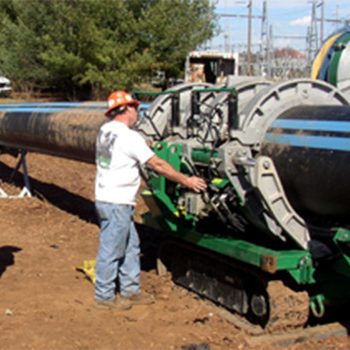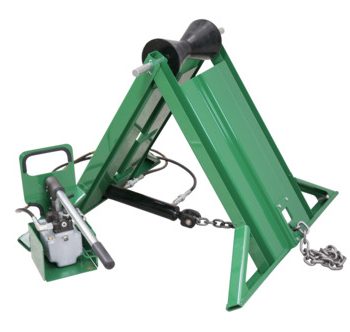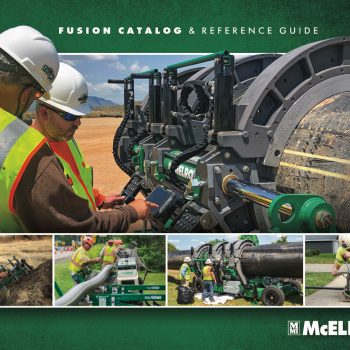Springfield, Missouri — A growing number of cities are deciding to lean on polyethylene pipe for the next 100 or so years. It is a decision perceived by some to be an unproven venture while others claim there is no better pipe in the world to deal with the troubles plaguing U.S. water infrastructure. Almost everyone agrees that major infrastructure rehabilitation is needed but the largest problem is lack of funding and not the choice of piping material.
City Utilities of Springfield, Missouri is one utility company that has started using high-density polyethylene for water. They recently installed one of the largest diameter high-density polyethylene (HDPE) potable water pipelines in the country.
“We have been using HDPE for some water projects for a couple of years now,” said Kem Reed, P.E., senior engineer at City Utilities. “It has been primarily used in cul-de-sacs and directional drilling applications.” Reed says that the previous method of installing pipe in cul-de-sacs required the use of several glued PVC 45 degree and 22- ½ degree ells. This created several potential leak locations and it was a time consuming process to install. City Utilities is now using a continuous piece of HDPE pipe around the cul-de-sac that virtually eliminates the possibility of leaks. The use of HDPE in directional drilling applications has also been advantageous in many recent street-widening projects in Springfield.
This was a good alternative for efficient use of limited funds
Springfield is working to keep their infrastructure in good working condition but much of the country’s infrastructure is in dire need of rehabilitation. The American Society of Civil Engineers 2005 Report Card for American Infrastructure says that an investment of $ 115 billion is needed over the next five years for water and sewer infrastructure. The Congressional Budget Office (CBO) concluded in 2003 that “current funding from all levels of government and current revenues generated from ratepayers will not be sufficient to meet the nation’s future demand for water infrastructure.” Not meeting these investment needs means putting the public’s health, environment and the economy in jeopardy.
It is not as if America ‘s decaying infrastructure is the result of poor planning or work. In fact, the distribution of water has been one of the greatest and most efficient achievements of the 20 th Century and the National Association of Engineers ranked clean water distribution fourth in order of importance as having the greatest impact on the quality of life in the U.S. Putting this into perspective, achievements in the water industry rank just under the introduction of the airplane and just above the importance of electronics. We have relied on the hard work of the men and women of the early 20 th Century for our present water system but it is reaching the end of its life-cycle and our neglect is starting to show.
The ASCE feels clean and safe water is no less a national priority than are national defense, interstate highways, and the aviation system. These other infrastructure programs receive sustainable, long-term federal grant programs; under current policy, water and wastewater infrastructure do not. The current federal budget process does not differentiate between expenditures for current consumption and long-term investment. This causes major inefficiencies in the planning, design and construction process for long-term investments. A capital budget system would help Congress to focus on programs devoted to long-term results. The facts are clear, and neither Federal assistance nor rate hikes have kept pace with demand for our infrastructure.
The Springfield water job consisted of an 800-foot section of 25 year old 36″ concrete transmission pipe that had experienced a major main break on a different portion of the same line in the summer of 2003. This 800-foot section was in the back yards of 10 recently constructed homes. City Utilities decided to use a slip-lining technique to insert 30″ HDPE DR11 into the suspect concrete pipe. The pipe was first butt fused together by PolyPro fusion contractors using a McElroy TracStar 900 fusion machine. The TracStar series of fusion equipment is mounted on a track system that makes the fusion machine mobile on the jobsite. The pipe was fused into an 800-foot string along the right-of-way. Butt fusion is the process of using heat and pressure to connect polyethylene pipe end to end. The ends of the pipe are melted with a heater and after it has become molten, the pipe ends are pressed together and held until the melt cools. The resulting joint is stronger than the pipe so there is no need to reinforce the joint.
“With fused joints, the pipe becomes a monolithic structure and has no joint,” said Tom Cravens, owner of Poly-Pro. “HDPE pipe has consistently proven itself in problem areas and bores. We are now seeing more and more cities and rural water districts choosing polyethylene pipe for the rest of their system.”
A cap was fused onto the front of the pipeline to prevent anything from entering the pipe during the operation. Entrance and exit pits were established and the existing line opened up for the insertion. Bill Davis, owner of Davis Structure and Development Corporation (General Contractor for the project based in Springfield ), decided to employ a pushing method by using a sling around the HDPE pipe and hooking that to a backhoe bucket. The pipe was then pushed into the existing pipe until it emerged from the exit pit. An MJ Adapter was then fused on the exit end of the pipe to attach to the existing ductile iron pipe at the end of the exit pit. An MJ adapter was also fused on the opposite end to attach to a section of ductile iron pipe that had been connected to the concrete pipe.
City Utilities feels that the HDPE slip-line operation is a good solution to this portion of its over 1,100 miles of water main. “This was a good alternative for efficient use of limited funds,” said Reed who estimated that the choice of HDPE saved the city $60,000 not including expenses that would have occurred for the ten properties that the line traversed. But unfortunately, there is not enough money to rehab Springfield ‘s entire infrastructure. They are forced, like many cities across the country, to use the patch and pray method while juggling money and trying to buy a few more years of life for parts of their system.
Some feel that Americans have been getting a cheap ride for water service and it is time to drastically raise rates. Others feel that it is time for infrastructure programs to receive a sustainable federal grant program so that long-term planning, design and construction solutions can be applied to water infrastructure. Whether or not the funding problem is resolved, new solutions are needed for what amounts to nearly $1 trillion dollars in critical water and wastewater infrastructure. HDPE’s material benefits are becoming recognized by the water industry and cities like Springfield feel its long life benefits are a solution worth bearing in mind.


